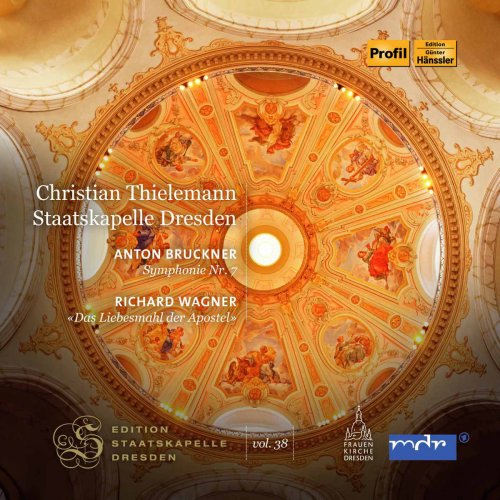Dresden Staatskapelle & Christian Thielemann - Bruckner: Symphony No. 7 in E Major, WAB 107 - Wagner: Das Liebesmahl der Apostel, WWV 69 (2016)

Artist: Dresden Staatskapelle, Christian Thielemann
Title: Bruckner: Symphony No. 7 in E Major, WAB 107 - Wagner: Das Liebesmahl der Apostel, WWV 69 (Staatskapelle Dresden Edition, Vol. 38)
Year Of Release: 2016
Label: Profil
Genre: Classical
Quality: flac lossless
Total Time: 01:39:40
Total Size: 448 mb
WebSite: Album Preview
TracklistTitle: Bruckner: Symphony No. 7 in E Major, WAB 107 - Wagner: Das Liebesmahl der Apostel, WWV 69 (Staatskapelle Dresden Edition, Vol. 38)
Year Of Release: 2016
Label: Profil
Genre: Classical
Quality: flac lossless
Total Time: 01:39:40
Total Size: 448 mb
WebSite: Album Preview
---------
CD1
01. Symphony No. 7 in E Major, WAB 107 (Original 1885 Version, Ed. R. Haas): I. Allegro moderato
02. Symphony No. 7 in E Major, WAB 107 (Original 1885 Version, Ed. R. Haas): II. Adagio. Sehr feierlich und sehr langsam
03. Symphony No. 7 in E Major, WAB 107 (Original 1885 Version, Ed. R. Haas): III. Scherzo: Sehr schnell
04. Symphony No. 7 in E Major, WAB 107 (Original 1885 Version, Ed. R. Haas): IV. Finale: Bewegt, doch nicht schnell
CD2
01. Das Liebesmahl der Apostel, WWV 69: Gegrüßt seid, Brüder, in des Herren Namen!
02. Das Liebesmahl der Apostel, WWV 69: Seid uns gegrüßt, ihr lieben Brüder
03. Das Liebesmahl der Apostel, WWV 69: Allmächt' ger Vater
04. Das Liebesmahl der Apostel, WWV 69: Seid getrost! Ich bin euch nah
05. Das Liebesmahl der Apostel, WWV 69: Welch Brausen erfüllt die Luft?
The Dresden State Orchestra (its official name is Sächsische Staatskapelle Dresden or Saxon State Orchestra Dresden) is one of the oldest orchestras in the world and is renowned for its special, well-blended sound.
The Dresden State Opera dates its founding to 1548 when the ruler, Elector Moritz, founded a Hofkantorei (Court Chorus) and brought in foreign musicians to augment it. Dresden came to possess one of the finest royal musical establishments in Europe, under the leadership of such stellar names as Michael Praetorius and Heinrich Schütz. Johann Adolf Hasse, Kapellmeister from 1734 to 1763, brought Dresden opera to its highest level during the Baroque.
Saxony's defeat in the Seven Years' War (1756-1763) required the opera to be curtailed drastically. Elector Friedrich Augustus III realized that the orchestra must be the nucleus if the opera were ever to rebuild its prestige. J.G. Naumann, director from 1776 to 1801, returned the Kapelle to the highest standards of instrumental playing. By 1810 the opera was again one of Europe's greatest.
The post-Napoleonic Congress of Vienna made Saxony a kingdom. In 1817, the director of the new Royal Kapelle founded a German Opera in addition the established Italian troupe. Under the leadership of Carl Maria von Weber from 1817-1826, this company won the favor of the populace. The Italian company disbanded in 1832. Kapellmeister Karl Gottlieb Reissinger maintained high standards, assisted by Richard Wagner until the later was exiled in 1849 for revolutionary activities. Wagner premiered his Rienzi, Flying Dutchman and Tannhäuser in Dresden's new opera house, opened in 1841, designed by Gottfried Semper. Wagner called the orchestra a "magic harp" that stimulated his ideas of orchestration and led it often in symphony concerts.
The orchestra presented its first concert series in 1858. In 1869 the Royal Opera Theater burned down. When a new concert hall, the Gewerbehausall, opened in 1870, the orchestra gave its concerts there (along with the newly formed Dresden Philharmonic) until 1878, when a second Semper-designed opera house opened. The music director of opera and orchestra from 1882 to 1914 was Ernst von Schuch, who gave the premieres of Strauss' Feuersnot, Salome, Elektra, and Der Rosenkavalier at the Semperoper.
After World War I, the Royal Kapelle became the Sächsischer Staatsoper and the Sachsischer Staatskapelle. The orchestra remains the orchestra of the opera, which is still also called the Semperoper. In 1923, the orchestra founded its own orchestral school under Fritz Busch (later under Karl Böhm), now known as the State Academy for Music and Theater. The majority of musicians in the orchestra are natives of the region and graduates of the school, a reason for the remarkable continuity of its special sound.
The second Semper Opera House was destroyed by bombing in 1945. After the war, the orchestra and the opera performed in temporary halls until 1948, when a city theater was remodeled and opened as the Grosses Haus of a state theater complex. Joseph Keilberth brought the opera and the orchestra both to their feet as music director from 1945 to 1950. His successors with the orchestra included Rudolf Kempe, Lovro von Matacic, Othmar Suitner and Kurt Sanderling, while Rudolf Neuhaus was general music director of the opera. In 1975, Herbert Blomstedt became conductor of both the orchestra and the opera.
In 1985, the opera and orchestra again regained their own home when the replacement Semperoper (built on Semper's plans for the second house) finally opened with a performance of Weber's Der Freischütz). Under Giuseppe Sinopoli, its conductor from 1991 to 2001, the Dresden Staatskapelle continued its tradition of performance at the highest level.





![Zamballarana - Sirena (2025) [Hi-Res] Zamballarana - Sirena (2025) [Hi-Res]](https://www.dibpic.com/uploads/posts/2025-12/1765620486_bhmusoyvnhizd_600.jpg)


